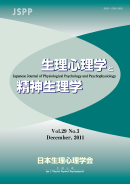All issues

Volume 11 (1993)
- Issue 2 Pages 47-
- Issue 1 Pages 1-
Volume 11, Issue 2
Displaying 1-6 of 6 articles from this issue
- |<
- <
- 1
- >
- >|
-
Yukihiro SAWADA, Gohoichi TANAKA1993Volume 11Issue 2 Pages 47-58
Published: December 31, 1993
Released on J-STAGE: November 27, 2012
JOURNAL FREE ACCESSNoninvasive techniques for measuring blood flow have recently been of great interest in cardiovascular psychophysiology. Among these, impedance plethysmography is often used for measuring stroke volume and cardiac output (=stroke volume × heart rate) and sometimes used for measuring forearm blood flow. This review describes the basic principles and techniques of blood flow measurement by use of impedance plethysmography in the thoracic and forearm regions. On the basis of the so-called “parallel conductor model” (by J. Nyboer), the equation estimating stroke volume and forearm blood flow is uniformly derived. The importance of obtaining blood pressure is noticed because this enables the calculation of peripheral vascular resistance (=mean blood pressure/cardiac output) and forearm vascular resistance (=mean blood pressure/forearm blood flow). This review is also concerned with systolic time intervals (pre-ejection period, left ventricular ejection time, QS2 or electro-mechanical systole, QT/QS2) : the by-products of impedance plethysmography and the parameters that seem to indicate beta-adrenergic activity. Validities and some controversial problems, as well as the limitations, in relation to these matters are discussed.View full abstractDownload PDF (1592K) -
Sachiko MURATA, Takashi MOROTOMI1993Volume 11Issue 2 Pages 59-67
Published: December 31, 1993
Released on J-STAGE: November 27, 2012
JOURNAL FREE ACCESSEvent-related potentials (ERPs) were recorded during a paired-associate learning task to investigate electrophysiological concomitants of the memory task. Eight college students were presented with a “stimulus” geometric figure and a “response” picture to be memorized (Study session). After the study session, they were asked to recall the “response” picture (Recall session). Both the Study and Recall sessions had four blocks. During the Study session, ERPs were recorded as a pair of stimuli. The number of recollected “response” pictures increased along with the repetition of the block. The P300 component of ERPs following the second of a pair was maximal in the parietal area. The amplitude of P300 increased and the peak latency of P300 decreased with repetition. These results suggest that P300 was sensitive to memory acquisition and racall processes. Increased positivity observed in ERPs evoked in paired-associate learning tasks results not only from the enhancement of late positive components, but also from the attenuation of negative-going components.View full abstractDownload PDF (1011K) -
Development of a measurement system for head movement and application to childrenTakanori MAESAKO, Toshihide KOIKE1993Volume 11Issue 2 Pages 69-76
Published: December 31, 1993
Released on J-STAGE: November 27, 2012
JOURNAL FREE ACCESSIn order to measure eye-head coordination in children, an apparatus for measuring head movements was developed by a sensor of terrestrial magnetism. The sensor on a head detects terrestrial magnetism which relates to the change of direction of head. The sensor was so light weight (100g) that there was no difficulty in installing the sensor on head of a child. The eye movement was recorded by the horizontal electrooculography. Trajectory of gaze was accurately constructed from summation of movements of eye and head. Applying this apparatus to a child of 6 years of age, characteristic pattern of head and eye movement was found during shifts of gaze to targets beyond the oculomotor range. Results indicate that the present apparatus is effective in measuring precisely eye-head coordination of children.View full abstractDownload PDF (932K) -
Kazuo HARA1993Volume 11Issue 2 Pages 77-84
Published: December 31, 1993
Released on J-STAGE: November 27, 2012
JOURNAL FREE ACCESSThis is the summary of the presidential address delivered at the 11th Annual Meeting of JSPPP at ICU in June, 1993, which discussed, with an appeal to our younger members for serious concerns, on four topics as follows : 1) the very nature of physiological psychology as the core of the mind-body problem, 2) the relationships between the speaker's researches and some theoretical models, 3) the significance of physiological psychology in the curriculum development for undergraduate program, and 4) the new roles of JSPPP as an academic society for the future.View full abstractDownload PDF (1058K) -
[in Japanese]1993Volume 11Issue 2 Pages 85-89
Published: December 31, 1993
Released on J-STAGE: November 27, 2012
JOURNAL FREE ACCESSDownload PDF (603K) -
1993Volume 11Issue 2 Pages 90-111
Published: December 31, 1993
Released on J-STAGE: November 27, 2012
JOURNAL FREE ACCESSDownload PDF (3037K)
- |<
- <
- 1
- >
- >|